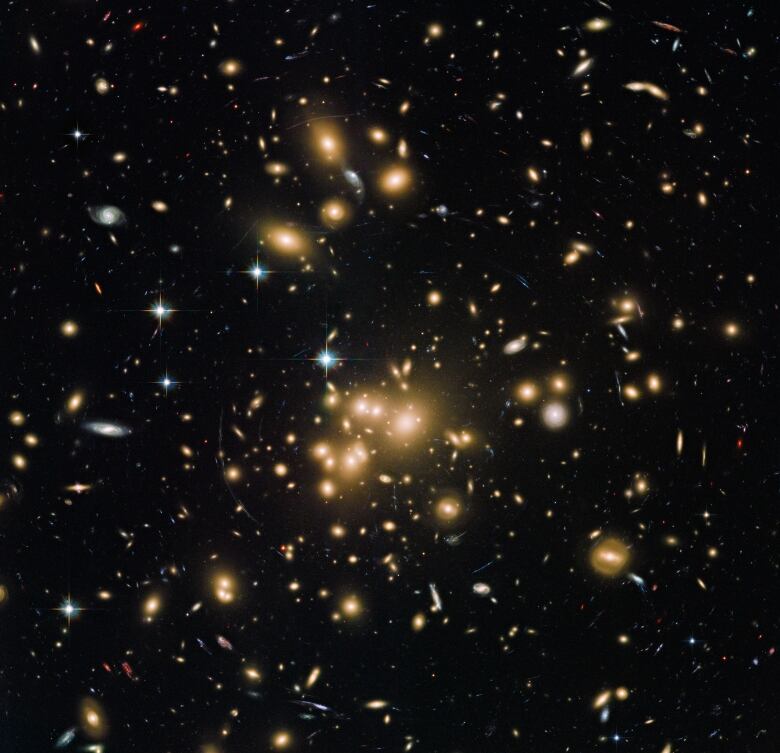Newly found galaxy cluster could become most massive structure in universe
'We've never observed a cluster like this before,' Canadian astronomer says

About 12.4 billion light-years from Earth lies a collection of galaxies that could end up as the most massive structure in the universe.
An international group of astronomers, including researchers from Dalhousie University and the University of Victoria, found the cluster using the South Pole Telescope in Antarctica. The telescope doesn't observe in optical light but rather in short wavelengths called submillimetre and millimetre. This allows it to peer into dark clouds and delve deeper into star formation and into the earliest time in our universe.
The team found a particularly bright source and followed up using telescopes in Chile. Their observations revealed that one source, dubbed SPT2349-56, is giving birth to stars 14 that they observed at an astonishing rate.
"In the Milky Way, the star formation rate is like two or three [solar masses a year] ," lead author of the paper published Wednesday in the journal Nature, Tim Miller, told CBC News. "But the star formation rate that we see, in this galaxy, ranges from about 50 to 1,000 times that of the Milky Way. They're forming at a spectacular rate."
That's unusual. In a way, that's kind of mind-blowing.- Arif Babul, University of Victoria
What's mind-blowing, the researchers say, is how massive the structure already is at such an incredibly young point in the universe's evolution. Something of this nature wasn't expected to have formed until about three billion years after the Big Bang. But this structure that is still in the process of forming is seen just 1.4 billion years after the Big Bang. Something that will become much larger isn't expected until at least 10 billion years.
Galactic dinner party
Our universe is full of clusters andsuperclustersof galaxies that can contain anywhere from hundreds to thousands of these galaxies. Our own Milky Way belongs to the Virgosupercluster, potentially home to more than 2,000 galaxies.
Astronomers believe that when these clusters form, at their centre lies a "gargantuan" galaxy that snacks on surrounding galaxies, growing in mass.
"They cannibalize these satellite galaxies around them and grow in dribs and drabs, so we don't really expect them to turn into massive systems until relatively recently," Arif Babul, co-author of the study and a professor at the University of Victoria, told CBC News. "Here you have 14 galaxies smashing together and forming something that resembles one of our gigantic galaxies in the universe. That's unusual. In a way, that's kind of mind-blowing."

Babul said thatwhile 14 galaxies are what they see in a very small region, there are additional galaxies spread around it, perhaps 50 or 60. And if you reach farther out, there could potentially be several hundreds or even thousands. While they won't necessarily become part of the core galaxy, they will eventually become part of the larger structure.
Over billions of years, the galaxy will become so big from swallowing everything in its nearby neighbourhood that only rarely will other galaxies wander in. It's like someone eating at a dinner table, Babul said, and running out of food.
"We've never observed a cluster like this before," said Miller, a Dalhousie University graduate student now at Yale University.
Rethinking clusters
This new cluster, or protocluster, contains a mass that is almost 10 trillion times that of our sun.
A model from the researchers suggestthe newly discovered 14 galaxies will become one giant elliptical galaxy one of the most common in the universe with a halo of galaxies, dust and stars. It will then grow, achieving a mass 1,000 trillion times that of our sun, similar to one of the most well-studied clusters we know, the Coma cluster.
The Coma cluster is one of the richest known, lying 320 million light years away, and could span 20 million light years.
You can see just some of the rich galaxies in the European Space Agency video below. Aside from a handful of stars, everything you see is a galaxy.
Looking at this new and embryonic galaxy cluster will provide pieces to the puzzle into the origin ofclusters.
The discovery of this early forming cluster may just be an outlier, or it could indicate that the theory on cluster evolution has to be re-examined.
"But one of the joys of science is to find chinks in the armour, and it's the chinks that lead you to interesting discoveries," Babul said. "That's where exciting discoveries lie."












_(720p).jpg)


 OFFICIAL HD MUSIC VIDEO.jpg)
.jpg)



























































































